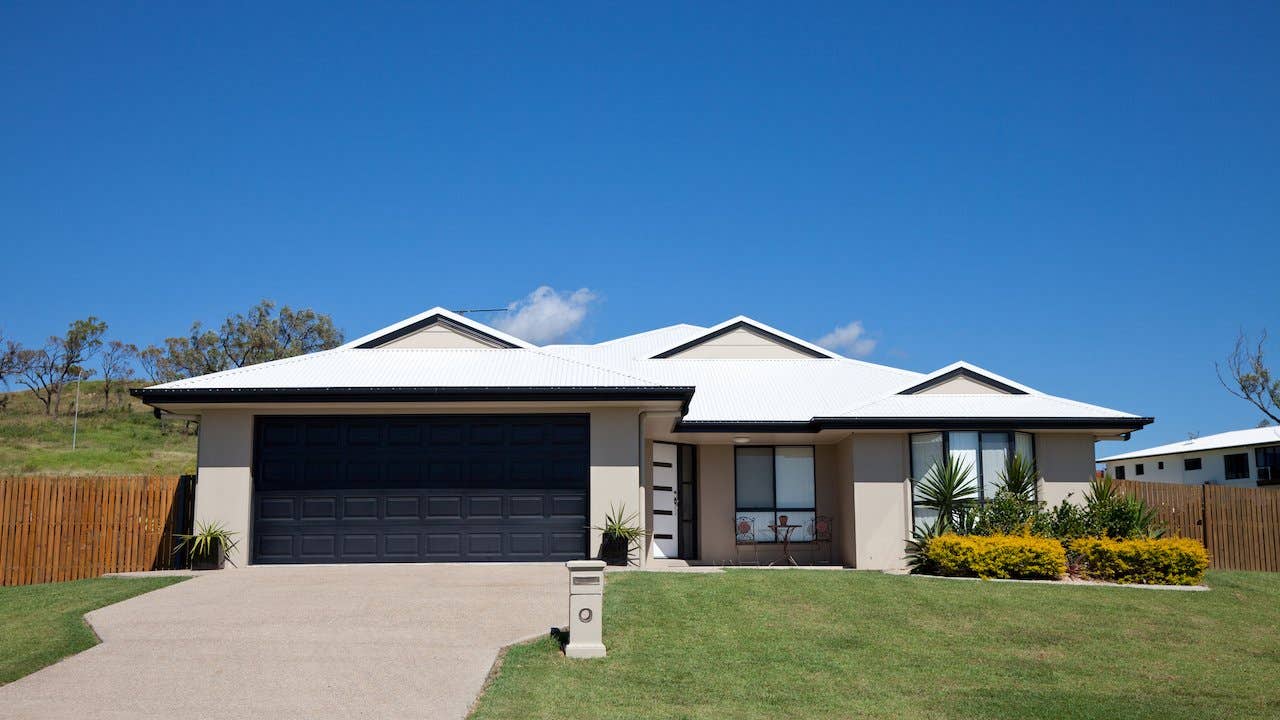What is a ranch-style home?




You’ve likely seen them scattered through neighborhoods where you live, and they’re typically a favorite choice among first-time homebuyers or those looking for ease of living.
We’re talking about ranch homes, which boomed in popularity after World War II and still remain popular for those looking to buy a house today. You’ll find a wide variety of ranch homes, old and new, throughout the country.
Let’s explore this simple yet functional housing style in more detail.
What is a ranch-style house?
A ranch house is typically a single-story home that features an open floor plan. These homes tend to be wider than they are deep, often with an L or U shape, and a lower-pitched roof.
Joe Dickerson, Realtor and founder of Joe Dickerson Group in Oakland, California, adds that the design of a ranch home gives you ease of access throughout the property.
“In my market, I see many homes that have purposeful indoor and outdoor flow, especially into the backyard,” Dickerson says. “Of course, these homes keep bedroom areas separate from living areas by using a hallway for access.”
In a ranch home, you’ll usually see the dining area and kitchen, along with the family/living room, combined into one open area with few, if any, walls separating the spaces. Many ranch homes have sliding glass doors that open onto a patio area in the backyard.
Ranch homes are usually built on a concrete slab, though some can have a basement or crawl space. Cliff May, the architect who is credited with designing the first ranch-style home in the 1930s in California, once said that his design was intentional to create a more informal outdoor living space.
Different types of ranch homes
Many variations of the style have cropped up over time since May popularized ranch homes almost a century ago. Generally, these different ranch styles still have an open floor plan, flat design and easy access to outdoor areas, but there are some nuances. Here’s a look at a few types of ranch homes:
California ranch
This is the style that May originally designed, and it typically features Spanish architectural influences. Some people lump California ranch and suburban ranch styles together.
Raised ranch
Sometimes referred to as split-entry homes, these have two floors, one at slab level and one above. You enter the home at a landing halfway between the floors and go up or down via short flights of stairs.
Split-level ranch
A split-level is similar to a raised ranch, but it has three levels. Usually there’s a kitchen and living space in the middle, then a short set of stairs down to additional rooms and more stairs leading up to the bedrooms.
Storybook ranch
These ranch homes have more elaborate designs reminiscent of fairytale cottages and might feature steep gables or decorative shingles and chimneys. Storybook ranch homes first became popular in California.
Suburban ranch
These homes grew common after World War II as people began moving to the suburbs. They are basic and easy to build en masse, making them ideal for new developments outside of cities. They typically have simple exteriors, concrete foundations and open-concept interiors.
Pros and cons of living in a ranch home
Pros
- Easy to maintain: With a single-story ranch home, maintenance and repairs aren’t as difficult or arduous as with multi-level homes. For instance, cleaning gutters or making exterior repairs doesn’t require getting up to a second or even third story.
- Great for those with limited mobility: One of the main advantages of living in a ranch home is that they’re easier to move around in. That’s ideal for disabled or elderly homeowners, or anyone with mobility issues.
- Can be safer: Single-story living makes it easier to evacuate in an emergency, like if there’s a fire. It also removes the danger of a steep flight of stairs that could be fallen down — an important consideration for families with small children.
Cons
- Less privacy: With bedrooms and living areas all on a single level, you might feel like you have less privacy than in a home with the bedrooms upstairs. Same goes for the open floor plan; you may prefer your living area to be completely separate from the dining area or kitchen, for example.
- Smaller yard: Ranch homes tend to be more spread out on their lots, which can mean less yard space. While less lawn to take care of may be a plus for some, it can be a turn-off if you want more green space for pets, children or gardening.
- Expensive to enlarge: If you want to increase the square footage of a ranch house, you’ll likely need to build a second story. That can add considerable cost and time to a major home addition.
Who are ranch homes best for?
Ranch houses are ideal for anyone who prefers single-story living. Many senior living communities offer them because they have better accessibility than multi-level homes.
Sizes of ranch homes vary across the country, so it’s really your preference. Ranch homes can be as small as 700 square feet or sprawl to 3,000 square feet or more, depending on the area and how much land the home is built on.
Ranches are also ideal for those who enjoy open floor plans and indoor-outdoor flow, and those who don’t intend on doing major renovations or want an easier-to-maintain style of home.
How ranches compare to other types of homes
An experienced real estate agent can help you decide whether a ranch is a good fit for you. But no matter what style of home you opt for, get a professional home inspection to ensure it’s in good condition.
| Home type | Who it’s right for |
|---|---|
| Apartment | Apartments are suited for anyone looking to stay in a prime location for a cheaper price near shopping, restaurant and entertainment centers, often at a more affordable cost than buying a condo or single-family home. |
| Condominium | Condos appeal to those looking for lower-maintenance living, a home with a sense of security and opportunities to be social with neighbors, among other factors. |
| Townhouse | Townhouses are a particularly good option for first-time homebuyers or other budget-minded home buyers who want more space than typically afforded in a condo. |
| Modular home | Modular homes are enticing to empty-nesters looking to downsize, couples looking for backyard units like tiny homes or families looking to upgrade their dated properties in nice but expensive neighborhoods. |
| Single-family home | Single-family homes are best for families who prefer a huge yard and plenty of room to spread out. Others still prefer a low-maintenance condo or townhome that includes benefits like landscaping, snow removal and exterior maintenance. |
| Multi-family home | Multi-family homes are best for those who are interested in getting into real estate investing and are comfortable with the added responsibility and time commitment that comes with being a landlord. |
| Bungalow home | At between 1,000 and 2,000 square feet, bungalows are a great option for young families looking for a starter home or retirees hoping to downsize in a home without stairs, or single homeowners who want the single-family home lifestyle without managing a huge property. |
| Co-op | Co-ops are most often found in major cities, and they can be good for those looking for security or neighbors who largely adhere to the building’s rules and policies. |
| Patio home | Typically capped at one-and-a-half stories and part of a larger association, patio homes are best for homeowners who don’t want to deal with stairs or maintenance. |
| Ranch home | Ranch homes are ideal for anyone who prefers single-story living. Singles, couples and families with children can find something to love about a ranch home. |
Why we ask for feedback Your feedback helps us improve our content and services. It takes less than a minute to complete.
Your responses are anonymous and will only be used for improving our website.




